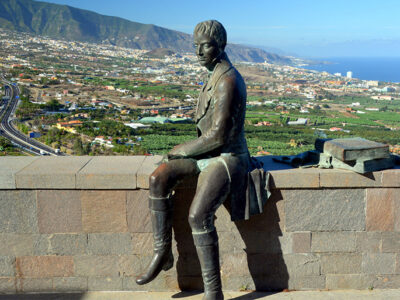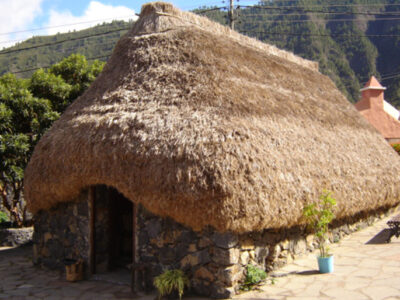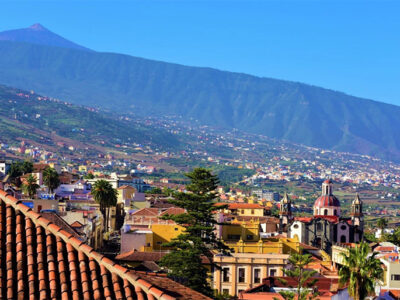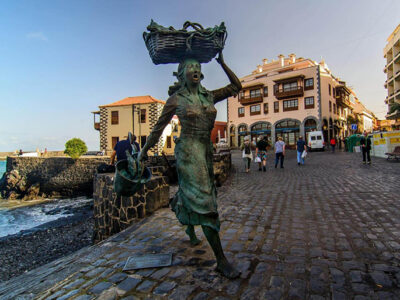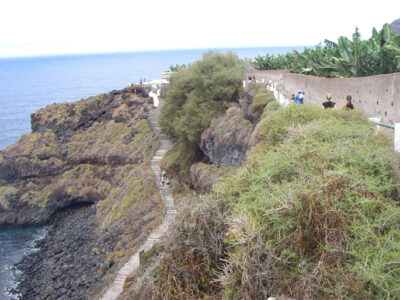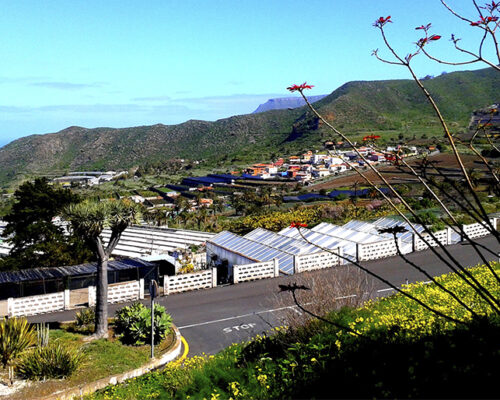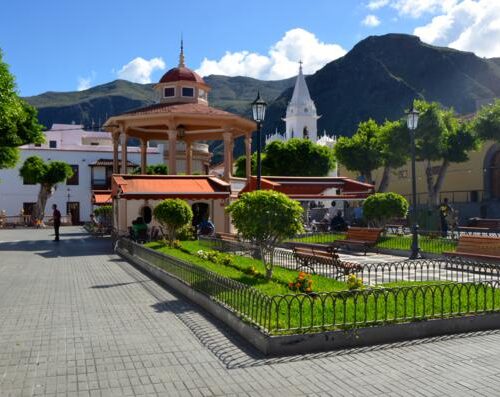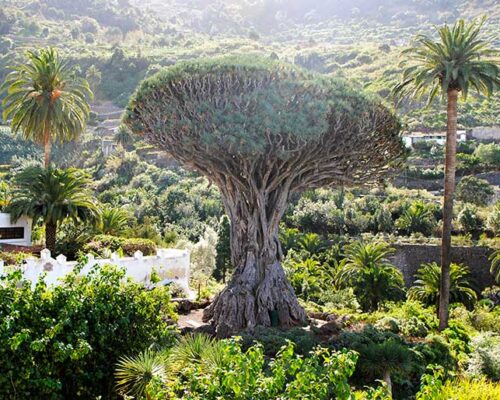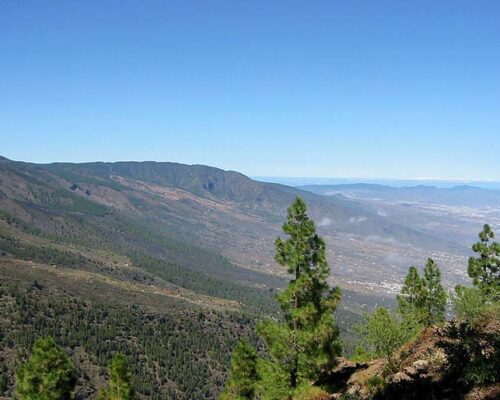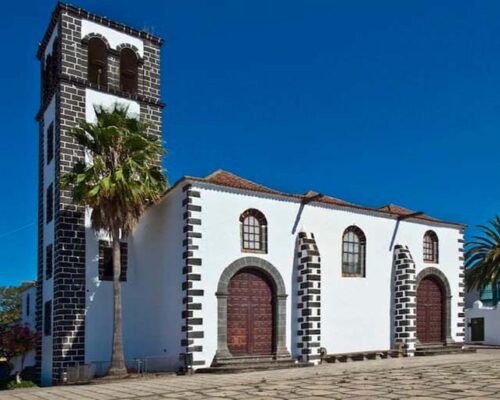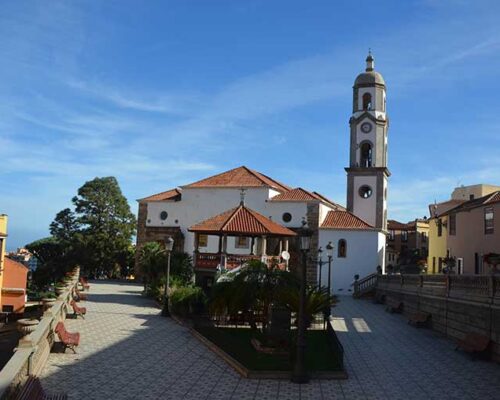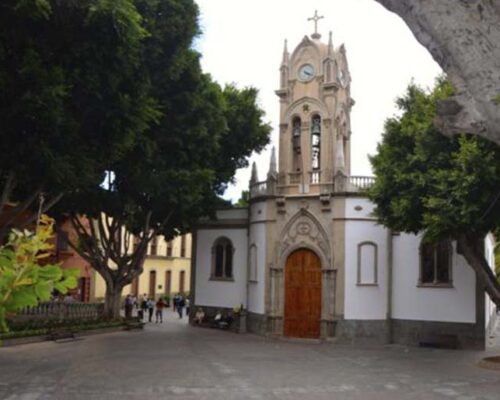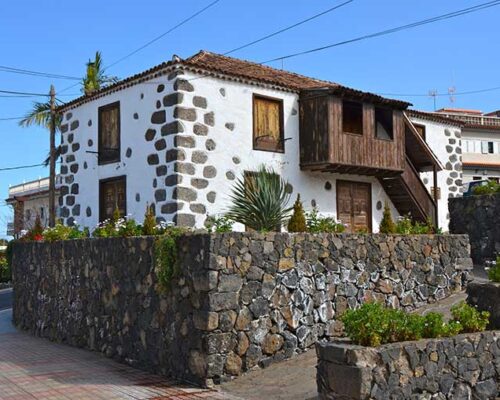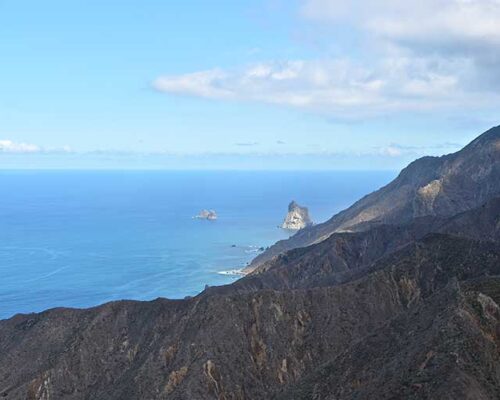
Route through Valle de La Orotava
Tradition at the foot of Mount Teide
The Orotava Valley, whose beauty and exceptional climate have attracted the interest of naturalists and scientists from around the world for centuries, occupies an honoured place in the history and tradition of Tenerife. This route offers you the opportunity to enjoy its great historical legacy and some of the most ancient traditions of its rural environment. The visit begins with the exceptional views of the Orotava Valley that you can see from the Humboldt viewpoint, on the TF-21, and with a stroll through the historic city, which gave its name to the valley. The town of La Orotava is the largest municipality on the Island and preserves some of the best examples of civil and religious architecture in the Canaries. The richness and diversity of this heritage has earned it the title of a Historical Artistic Quarter and because of its unique architecture, is included in the “Inventory of European Cultural Heritage”. There are so many attractive buildings of interest, that the best you can do is to amble through its cobbled streets and not miss those that are open to the public: churches, museums, shops and public buildings. Its museums are a point of reference, like the Folklore Museum at Pinolere, or the Ibero-American Craft Museum housed in the former convent of Santo Domingo, with over 7,000 craft items from America and Spain on display.
ACUEDUCTO DE LOS MOLINOS (The Mills’ Aqueduct)
Location: Residential development La Duquesa, behind the Casa Lercaro. La Orotava.
In order to make the most of the wealth of water resources of the Orotava Valley, once the conquest of the island was complete, the colonists built an aqueduct or water channel through the nascent town of La Orotava. Along its length they built as many as 13 water mills, of which nowadays 10 are still preserved, two of them at present still functioning and used to mill “gofio” (roasted, ground grains), as well as some public clothes washing basins. The course of the former aqueduct, of which there are hardly any remnants apart from the mills themselves, ran along what are nowadays Doctor Domingo González García, San Francisco and Colegio streets. The mills’ aqueduct has been declared a Site of Cultural Interest, categorised as an Ethnological Site.
TORREHERMOSA HOUSE
Location: Calle Tomás Zerolo, 27. La Orotava
Tel:922 322 285 / 922 334 013
This splendid mansion dating from the XVIth century is at present the headquarters of Artenerife, the Island Company of Handicrafts created by the Cabildo of Tenerife [Island Economic Council] to bring the Island crafts back to life. More than 1,500 different articles are on display in the shop and museum. Situated in the historical town centre of the town of La Orotava, its interior houses a patio in mudejar style with wooden galleries, typical of the Canary Islands. Opening times: From Monday to Friday: from 10:00 to 15:00
RAMBLA DE CASTRO
Location: Main Road Santa Cruz-Icod de los Vinos (TF-5). Km. Los Realejos.
The Rambla de Castro is a natural site of great scenic value. Nestling in the coastal strip of the municipality of Los Realejos, it covers 45.9 hectares and gives beautiful panoramic views along the north coast of Tenerife. This green beauty spot situated on the shore of the Atlantic is surrounded by a great variety of flora such as palm trees, dragon trees and bananas. It contains a number of exceptional, characteristic buildings such as the Hacienda de Castro whose origins go back to the XVIth century, although in fact the present building is from the XVIIIth century; the Fortín de San Fernando (fort), that served to fend off attacks by pirates; the Gordejuela building, which housed the first steam engine on the Island, and the chapel of San Pedro. A visit to this area gives the visitor a range of choices. First of all, the Rambla de Castro forms part of the “Sendero del Agua” (coastal path) which starts from the Hotel Marítim (in Los Realejos), crosses the Los Roques beach, La Romántica residential estate, the Rambla de Castro and finishes at the San Pedro viewpoint. Walking the whole path allows you to enjoy a pleasant excursion and discover this delightful spot on Tenerife’s north coast. You can also access the Rambla from the San Pedro viewpoint and take a stroll through it, visiting its most characteristic buildings and open spaces and take in the spectacular views of the Atlantic from the viewpoint.
CENTRE TELESFORO BRAVO
Location: C/ Doctor Sixto Perera González, 25. La Orotava
Tel:922 922 371
The Telesforo Bravo Information and Visitor Centre´s main objective is to inform visitors about Mount Teide and Illustrate the main features of the Park. The exhibitions shows the peak of Mt. Teide from different points of view. It offers the impressions of a simulated ascent from sea to summit, by way of the Valley of La Orotava, following in the steps of Alexander von Humboldt who visited Tenerife in 1799. It also consists of panels, screens, interactive displays, etc., intended to explain to visitors the main features of the Teide National Park. The exhibition is rounded off by an area devoted to the Network of National Parks.
Route points
The Humboldt viewpoint is situated at the foot of the slopes of Santa Úrsula, right next to the road from El Pinito. From here there are spectacular views of the Orotava Valley, between the slopes of Tigaiga and Santa Úrsula, the silhouette of Mount Teide and the nearby volcanoes of Las Arenas and El Fraile. The facilities, which include a cafeteria, pay homage to the illustrious German scientist and naturalist, Alexander von Humboldt, who visited the Island of Tenerife during one of his famous journeys and in his works described the beauty of this valley. A small exhibition dedicated to his importance as a scientific figure, completes the offer of this avant-garde architectural viewpoint.
The Pinolere Folklore Museum is situated in the park of the same name, in the town of La Orotava. The exhibits of this original museum of popular culture recreate the history and the customs of this area of the middle slopes of northern Tenerife. The museum has various traditional constructions, such as pens, a threshing floor, a garden of medicinal herbs and the characteristic thatched houses or barns, nowadays converted into exhibition halls devoted to the art of basketry using strips of chestnut wood, and the history of the town. The two main subject areas that are developed in depth in this museum are the Juan González Fariña Museum of Canarian basketry, and the Francisco Luis Acosta Museum of History, the latter being complemented by the Guanche Cave.
The proposed pedestrian route through the historic centre of La Orotava, declared an Historical Artistic Quarter, and which wanders between large manor houses and along cobbled streets, allows visitors to see its many buildings and monuments. The walk through the historical centre of La Orotava begins in Carrera Escultor Estévez street, located next to the church of San Agustín, a few metres from a car park located behind the Teobaldo Power exhibition room. At the junction between Carrera Sculptor Estévez street and Tomás Pérez street you pass the Town Hall building on the left-hand side and walk up the second of the two streets and then on the right take Hermano Apolinar street to reach the junction with San Francisco street. There you will find the church of San Francisco and the Hospital of the Santísima Trinidad, which retains the portico of the former convent of San Lorenzo. Very near here, in Colegio, Carrera, San Agustín or adjacent streets, examples of noble Canarian architecture abound. These buildings were commissioned by some of the most important ruling families on the Island, who ordered their coat of arms to be carved on the facade. These are the houses of Benítez de Lugo, Molina, Franchy, Ascanio, that of the marquises of the Quinta Roja or the Casa Fonseca, also known as the “House of Balconies”. This last-mentioned, from the XVIIth century, is a magnificent example of the traditional island architecture with its masonry, wooden balconies and its magnificent interior patio. In these beautifully cobbled streets there also abound outstanding specimens of religious architecture such as the church and convent of San Agustin, also from the XVIIth century in the Plaza de la Constitution, or that of Nuestra Señora de la Concepción, whose building was declared a National Monument of Historic Art in 1948 and has two bell towers, a high dome and an interior divided into three naves.
The historical centre of Puerto de la Cruz, declared a Site of Cultural Interest within the category of a collection of historical buildings, retains many buildings of great heritage value, true witnesses of the history of this town which is part of the north of Tenerife. The Plaza del Charco (square) and the surrounding pedestrian streets invite you to stroll through the heart of the town and discover small gardens and parks, whilst enjoying the friendliness of the people and the large number of tourists of the most varied nationalities who choose this place as a holiday destination. The origins of Puerto de la Cruz go back to the period after the conquest of the Islands when these lands, which were included within the aboriginal kingdom of Taoro, were divided up among the Castilian settlers. Orders were given to build a quay on the coast and around it a small settlement devoted to fishing began to develop. As the years passed, Puerto de la Cruz started to gain importance in commercial activity; the destruction of the port of Garachico in the early XVIIIth century under the lava flows from the Trevejo volcano or Arenas Negras only served to underline the trend, thus turning Puerto de la Cruz into the Island's main harbour at that time. As a result, there came a period of strong economic, social and cultural development which inevitably meant political clashes with the Orotava aristocracy and resulted in the town becoming independent as a municipality in its own right in 1772. Part of its history is especially linked to the arrival of foreign visitors such as Agatha Christie or Alexander von Humboldt. The mildness of the Canarian climate and its tremendous scenic beauty early on attracted a considerable number of renowned foreigners. These first visitors laid the foundations for what was the future development of tourism which was to become the main motor of Puerto's economy. It is worth examining various buildings that recall former times of commercial splendour when Puerto de la Cruz was the entry and exit point of passengers and goods from Europe and America. As evidence of that past, there are buildings still standing that today allow us to see how life was lived in this town of northern Tenerife. Outstanding among them is the Casa Alfaro de Franchi (mansion house), then the Customs House which was erected by Francisco Tomás de Franchi Alfaro y Varcárcel, the Casa Miranda, the Marquesa Hotel, the Archaeological Museum, the church of La Peña de Francia or the chapel of San Telmo.
What is known as the "Coastal Path" is a footpath with a low level of difficulty starting at Aceviño Street in Puerto de la Cruz, in the La Paz residential area. The end of this road joins Cólogan Zuloeta Street; a few metres further on both streets as such end and this is where the coastal path starts which ends at Llano de Martiánez. The walk wanders among banana plantations and allows you to visit three well-known beaches. The first is the beach of San Juan, the second is El Bollullo and the third and last is Los Patos. The road continues towards the coast and permits walkers to discover a cultivated landscape which comes as something of a surprise and reveals the world of rural Puerto de la Cruz, and also takes you back to a time in the not too distant past when growing bananas was a way of life. What's more, it permits you to see wonderful views, typical of northern Tenerife's coast, and discover amazing beaches of black sand.

